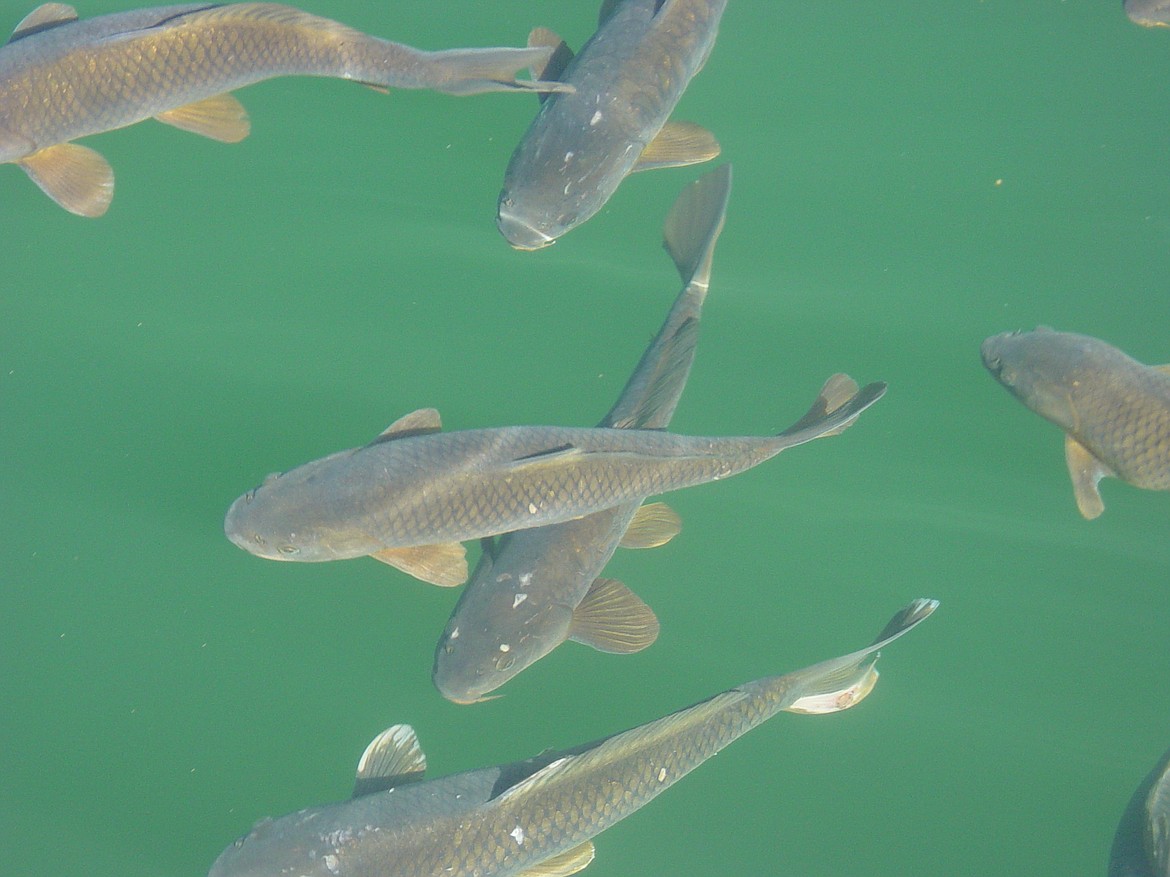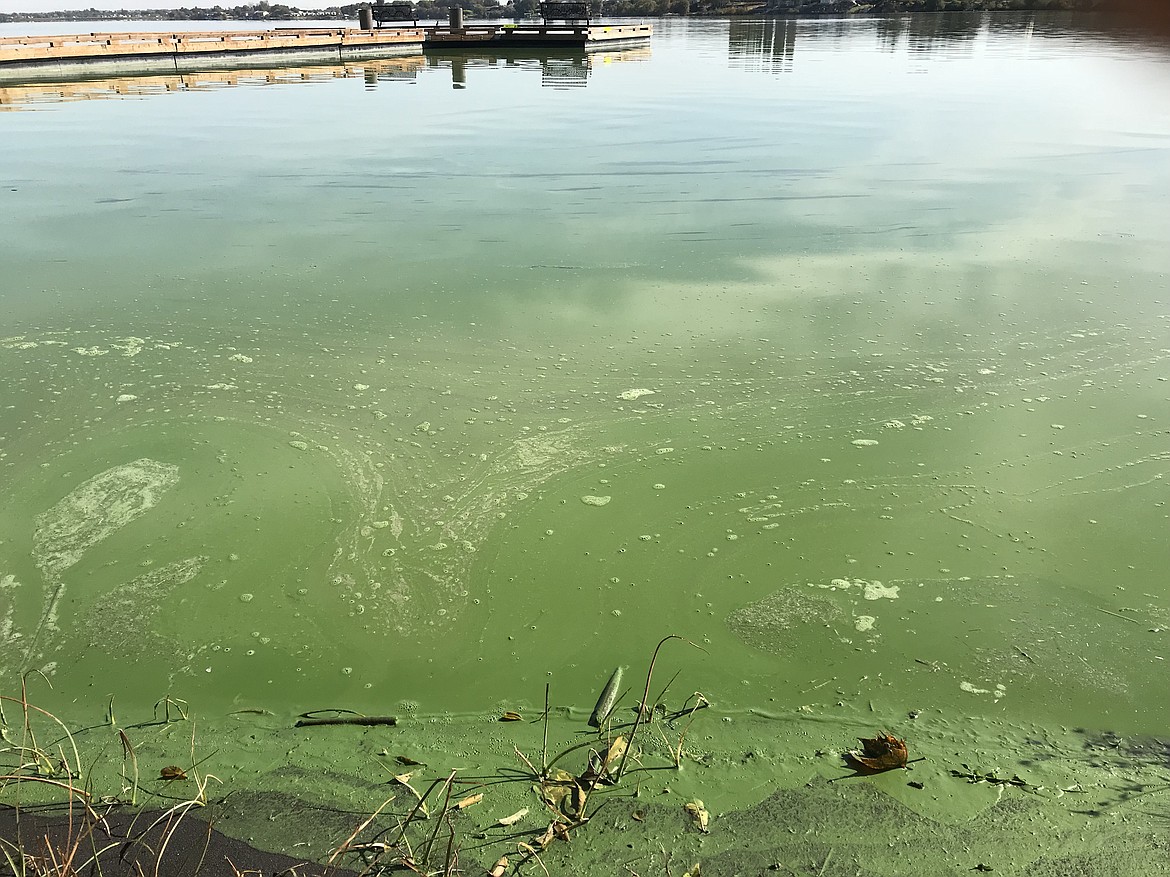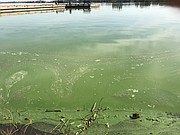Grant County’s carp: How they arrived and why they thrive in toxic algae
Common carp have large bronze-gold scales, barbels on each side of their mouths and serrated fins down their spines. According to the Department of Fish and Wildlife, they can grow up to about 47 inches and weigh more than 88 pounds.
In China and Japan, carp have been seen as strong and intelligent, a symbol for honor and courage, according to the American Carp Society. In the European Middle Ages, it was a food for royalty.
Today, they’re found virtually all over the United States, and in Grant County they’ve inundated Banks, Billy Clapp, Evergreen, Long, Moses and Soda lakes, as well as Potholes Reservoir.
While Moses Lake’s yearly blue-green algae (cyanobacteria) plume isn’t caused by carp, they certainly make it worse, said Moses Lake Watershed Council citizen representative Ty Swartout.
Common carp are bottom feeders. When they spawn, they kick up mud from the lakebed, releasing trapped phosphorus and nitrogen which feeds the algae, he said.
According to the state Department of Health, toxic algae blooms can kill native fish and waterfowl, as well as livestock and pets who swim in or drink the water. It can be harmful to humans too, leaving rashes and causing serious illnesses.
In Moses Lake, such blooms have left public beaches and parks closed for months at a time, shutting down most tourism and recreational activities.
But carp weren’t always the menace they’re currently perceived as.
Common carp were first introduced to the United States in 1877 per request of Dr. Spencer F. Baird, head of the newly formed United States Commission of Fish and Fisheries, according to the American Carp Society. Seen as a delicacy overseas, they are a big fish, proliferate profusely and can survive in diverse climates.
At first, the commission imported 345 common, mirror and leather carp in Baltimore ponds. A year later, they were in 24 states.
The common carp came to Moses Lake when it was still called Neppel, in the early 20th century. According to the city of Moses Lake website, the Great Depression crashed several industries, including a carp seining (netting) operation.
While the fish market was receptive at first to the new American flavor, enthusiasm quickly faded away, according to the National Park Service. Without the selective breeding practices from where carp came from, as well as declining quality of some bodies of water, American carp tasted much muddier than their foreign counterparts.
Able to survive in worse water conditions than most fish, carp have now been associated with polluted and toxic water, according to the National Park Service.
The algae bloom is a serious issue, Swartout said. If it’s not taken care of, there’s no fishing, no boating, no water skiing, no swimming, no lake recreation at all. Plus, it can spread to Potholes Reservoir, shutting down MarDon Resort and the majority of the region’s tourism.
While this may seem like a relatively recent problem, it isn’t, said Grant County Health District (GCHD) public information officer Misty Aguilar.
“The blue-green algae in Moses Lake has taken more of a spotlight recently because GCHD has been able to sample more than it has in the past,” she wrote in an email. “This is the first time we’ve sampled multiple locations around the lake over the course of more than one year. Not sampling or no samples doesn’t mean no toxins, just that it wasn’t sampled for. As the area around Moses Lake continues to see growth, the quality of the lake will continue to be something people are looking at.”
Moses Lake’s toxic algae blooms were bad in the mid-20th century, Swartout said, until the U.S. Bureau of Reclamation flushed water through the lake and greatly minimized the issue.
Around 2017, they stopped doing this due to a number of financial and political factors, Swartout said, resulting in large blooms in the summers of 2018 and 2019. Bureau representatives have since been attending Watershed Council meetings and have become aware of these issues, he said.
According to the GCHD, eliminating the toxic blooms is a community effort to keep phosphorus and nitrogen out of the lake. This includes maintaining and restoring native plants around shorelines, being cautious with lawn and plant fertilizers and pesticides, maintaining septic systems, preventing surface runoff from agricultural and livestock areas and preventing erosion around construction and logging sites.
On a large scale, the best thing to do to prevent the algae is to dilute the water like the Bureau of Reclamation did in the past, Swartout said. Number two is to manage the carp.
According to the Department of Fish and Wildlife, a number of recreational activities will reduce the number of carp in the lake such as hook-and-line fishing, fly fishing and bowfishing.
In Europe, carp remain a delicacy, common in the holidays. In Grant County, the Department of Fish and Wildlife encourages people to catch, keep and eat as many carp as they want, said fisheries biologist Michael Schmuck.
In May of last year, the Grant County Conservation District commissioned a commercial fisherman, who removed six and a half tons of carp from Moses Lake.
The county could also launch a Sport-Reward Fishery Program, Swartout said, paying anglers per fish, like the Department of Fish and Wildlife did with pikeminnows in the Columbia River.
The biggest obstacle is money, he said. These types of programs are expensive, as are some of the other potential solutions like water conditioners, such as HydroFLOW, out of Redmond, to be tested on the lake next year.
Swartout has hope, he said.
Because Grant County hasn’t had much rain in the past two months, the bureau just flushed water into Moses Lake, down to Potholes Reservoir and into farmlands near Royal City. Swartout said the lake is currently the cleanest he’s ever seen.
“(The Moses Lake Watershed Council) had a meeting last Tuesday (May 18), and I left that meeting the most enthusiastic I’ve been in probably a year and a half,” he said. “There seems to be a lot of positive vibes, and people are getting on board and the community is coming around some. It’s not all us against you; there’s things that we can make some compromises on.”





